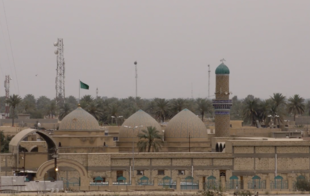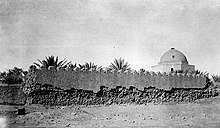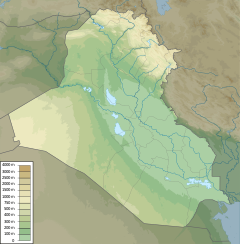| Mosque of Salman al-Farsi | |
|---|---|
Arabic: مسجد سلمان الفارسي | |
 | |
| Religion | |
| Affiliation | Shi'a [1] |
| District | Al-Mada'in |
| Province | Diyala Province |
| Status | Active |
| Location | |
| Location | Salman Pak, Iraq |
Location in
Iraq | |
| Geographic coordinates | 33°05′54″N 44°34′52″E / 33.0982656°N 44.5809823°E |
| Architecture | |
| Type | mosque and mausoleum |
| Style | Modern architecture with elements from Ottoman and Abbasid styles [2] |
| Date established | 1950 (mausoleum existed before that) |
| Specifications | |
| Capacity | at least 800 worshippers [2] |
| Interior area | 500 square metres |
| Dome(s) | 4 |
| Dome height (outer) | 17 metres (main dome) [2] |
| Minaret(s) | 2 |
| Minaret height | 23 metres [2] |
| Shrine(s) | 2 (one shrine for Salman al-Farsi, the other shrine for the companions) |
The Mosque of Salman al-Farsi ( Arabic: مسجد سلمان الفارسي) is a historic mosque located in the city of Salman Pak, Al-Mada'in district, Iraq. It contains the purported tomb of Salman al-Farsi, a Sahaba, and this the mosque is named after him.
It is historically a Sunni mosque, however, at some point of time the mosque was removed from the Sunni Endowment and given to the Shi'ite managements. [3]
History

The mosque was established in 1950 over a pre-existing mausoleum dedicated to Salman al-Farsi which was already in existence before the 1920s. In 1931, the bodies of Jabir ibn Abdullah, Hudhayfah ibn al-Yaman, and Ali al-Tahir ibn Muhammad al-Baqir were exhumed due to their graves being water-logged, and the bodies were transferred to new tombs next to the old mausoleum. [2] The report of the bodies being transferred is sometimes contested, however, as Jabir ibn Abdullah is reported to have died in Medina. [4] Later in 1950, the mosque was established over the mausoleum and new tombs, with funding from the Iraqi government. [5]
Modern history

In 2017, a new zarih was placed around the grave of Salman al-Farsi. [6] The ceremony of the placement of the zarih was also attended by Iraj Masjedi, the Iranian ambassador to Iraq, as well as several other Shi'ite clerics. [6]
Usage
The mosque is visited because of the sacred tombs within it. [2] However, the mosque also holds Qur'anic memorization courses as well as classes to study the Shari'ah law. [2] Religious festivals are held in the mosque as well. [2]
2006 attack
On February 24, 2006, during the year the Al-Askari Shrine was bombed, two rockets were fired by rebels, which landed in the area of the mosque. [7] Significant damage was caused to the building, but no casualties were reported. [7] [8] Damage was done to the main dome and a minaret. [2]
See also
References
- ^ Silverman, Adam L. (August 24, 2009). "Religion and Politics in Iraq: What Type of Sectarianism Really Exists?". Informed Comment. Retrieved February 5, 2019.
- ^ a b c d e f g h i "مرقد الصحابي الجليل سلمان المحمدي رضوان الله تعالى عليه - اسلاميات". 2017-04-28. Archived from the original on 2017-04-28. Retrieved 2023-12-13.
- ^ Silverman, Adam L. (August 24, 2009). "Religion and Politics in Iraq: What Type of Sectarianism Really Exists?". Informed Comment. Retrieved February 5, 2019.
- ^ IslamQA (2019-08-04). "Where is Jabir ibn Abdullah buried?". IslamQA. Retrieved 2023-12-13.
- ^ "جامع سلمان الفارسي (رضي الله عنه)". almd3aein.ahlamontada.net (in Arabic). Retrieved 2023-12-13.
- ^ a b "وضع الضريح على مرقد الصحابي سلمان الفارسي في المدائن - قناة العالم الاخبارية". www.alalam.ir (in Arabic). Retrieved 2023-12-13.
- ^ a b "Rockets hit Shia tomb in Iraq". Al Jazeera. February 27, 2006. Retrieved February 5, 2019.
- ^ "USATODAY.com - Holy Shiite tomb attacked with rockets". usatoday30.usatoday.com. Retrieved 2019-02-03.
